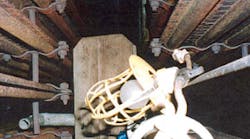Although electrical fatalities are by their very nature predictably unpredictable, they are almost always preventable — as can be evidenced by the events leading up to the following forensic casebook. For two laborers, their workday began just like any other day — each heading off to a job disassembling scaffolding. But this time, they faced extreme conditions, working in the tight confines of an industrial boiler. Neither could have anticipated that one man would be dead before day's end and the other would succumb to a debilitating heart disease four years later that was possibly linked to the events of that day. Looking back, what was about to happen truly hinged on a single momentary lapse of good judgment.
The environment
When the incident occurred, the pair was working in an area where the scaffolding rose several floors high inside a claustrophobically tight space between rows of metal tubes where temperatures approached 100∞F. The men entered through a small hatch and climbed up a ladder inside the tight confines of the boiler. Considering the workspace was less than 14 inches across, there was no room to turn around. The only light came from a 120V multi-light stringer, which was plugged into an outlet via an extension cord outside the boiler and tied to the scaffolding.
Disassembling the scaffolding piece by piece, the men passed the pieces (called legs) from man to man down to and then through the entrance hatch. The boiler tubes, which defined the boundaries of their confined workspace, were electrically grounded. It was impossible to avoid multiple point contact with electrical ground while working. While experts in this case would debate as to whether or not OSHA and company guidelines would allow 120V lighting due to the risk of electrocution, there was no debate that any 120V lighting had to be ground fault (GFCI) protected.
There was a temporary outlet panel set up on a wooden board that provided multiple GFCI-protected electrical outlets for any electrical power brought into the boiler. There was also a permanent outlet with no indications or markings that would suggest it was GFCI protected. The outlet was convenient to the entry hatch and was not part of the GFCI-protected outlet board. After the incident, there was debate whether this outlet was fed from a GFCI-protected circuit breaker but from all indications it was not GFCI protected at the time of the incident — and it clearly did not function as a GFCI outlet would. Someone, probably out of convenience, energized the stringer from the non-GFCI outlet. At some point, the plastic protective cover on one of the lights was damaged, allowing the light bulb to be exposed. At some point, the exposed light was broken, creating a dark area with an open 120V filament. When and how these events occurred is unknown. What is not in question was the tragedy that followed.
The accident
One of the two men came in contact with the energized filament and for the next 45 seconds screamed in pain, basically trapped as part of the circuit between the filament and the grounded tubes. The second man, working on a lower piece of scaffolding, claimed to have been shocked briefly. Finally, the lights were unplugged, a replacement bulb was passed into the dark workspace, and the lights were re-energized, revealing that the first worker lay dying from electrically induced fibrillation.
Co-workers tried to perform CPR on the victim without success. Although an automated external defibrillator was on-site, it was deemed too large to pass inside the work area. Although rescue crews arrived, they were not trained nor prepared to perform a confined space rescue. Therefore, it took 45 minutes to remove the body of the electrocuted man.
The investigation
In the litigation that ensued, both sides retained experts, and an extensive investigation began. I was retained by the plaintiff's counsel, who represented the family of the decedent as well as the second shock victim. My purpose was to reconstruct the electrical environment and to explain how the second victim could have been shocked when he was below the decedent and away from the exposed filament.
In addition to a site visit, my investigation consisted of reviewing all technical and some medical records, including OSHA documents, assorted reports, and multiple depositions. Although there was no question as to how the first man died, experts from both sides weighed in heavily with differing opinions as to how or if the second man had been shocked. After much investigation, my most probable explanation was that the decedent was passing a scaffolding leg down to the second man when the decedent was shocked, thus conducting electricity to the second man on the lower scaffolding level. The survivor offered testimony that both supported and contradicted this theory. He remembered reaching for a leg, but was fairly certain he never made contact with the leg at the instant of the shock. A second theory set forth by one of the plaintiff's other experts was that electricity was conducted down the scaffolding to the second man. Because the metal scaffolding was in imperfect contact with the grounded pipes by way of multiple metal ties, the plaintiff's experts ultimately agreed that this theory was less likely.
The defense argued that the second man was not shocked because the extensively grounded environment would have made it impossible to create a conductive pathway to the lower scaffolding level. Ironically, the defense theory in some ways supported my shock theory. The defense theory, which had certain obvious validity, limited the ways in which current could have been delivered to the second man on the lower scaffolding. The only explanation that did not contradict their theory was that the current must have been delivered via a pathway that could not have been in contact with ground. The only reasonable pathway was through a scaffolding leg that was in contact with both men at the time of the shock.
The most puzzling issue was with regard to the medical condition of the shock survivor. My partner, Dr. Jennifer Morse, MD, was retained to analyze the medical problems that plagued the surviving victim after the incident. Immediately following the accident, the survivor developed symptoms consistent with an electrical contact. Four years later, he also developed cardiomyopathy and hypertension that created the need for an implanted defibrillator. At the time of the electrical contact, he was 43 years old and — from all outward appearances — a healthy individual without any medical indications that he was destined for such a critical condition. There was some debate whether or not the man had pre-existing hypertension. To address this issue, both sides offered up experts who supported and refuted the issue of electrically induced, long-term cardiomyopathy; however, literature on the subject was ambiguous at best. The issue was never resolved to either side's satisfaction. Sadly, the man died from his ailments before the case reached resolution.
The verdict
The case settled for an undisclosed amount; however, many questions remained unanswered. Had the case gone to trial, a jury would have been left to decide numerous unknowns. It was discovered that a third party owned the light stringer and provided lighting within the boiler. However, there was an issue as to whether or not this company had allowed other contractors access to its supply trailer. It was also never determined who actually plugged the extension cord into the non-GFCI outlet. Furthermore, there were questions as to whether or not the non-GFCI outlet should have been locked out to prevent such an occurrence.
The lesson
Whatever rules may have been broken and where liability would have been placed by a jury become mere academic questions when life is lost. No matter how the accident occurred, one small error created a volatile electrical environment. If whoever plugged the lighting in had GFCI protected the stringer, the bulb could have broken, but the GFCI would have tripped, turning this tragedy into a non-incident.
Morse is a researcher and consultant, and serves as a full professor of electrical engineering at the University of San Diego.



